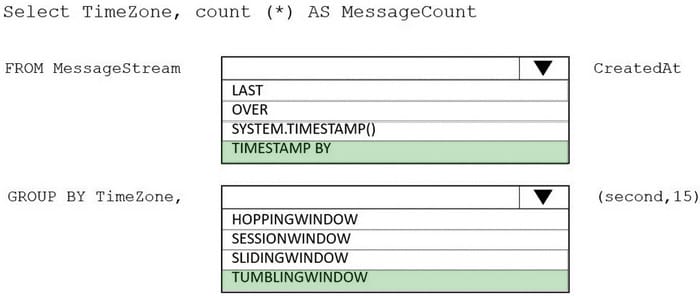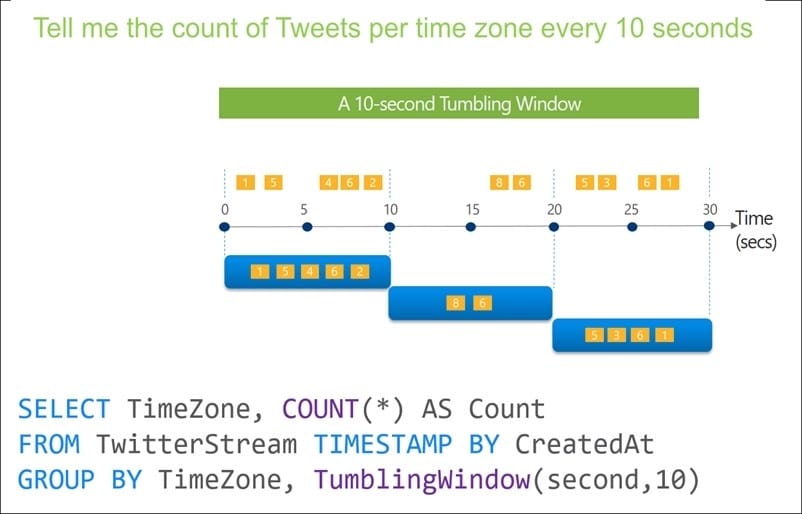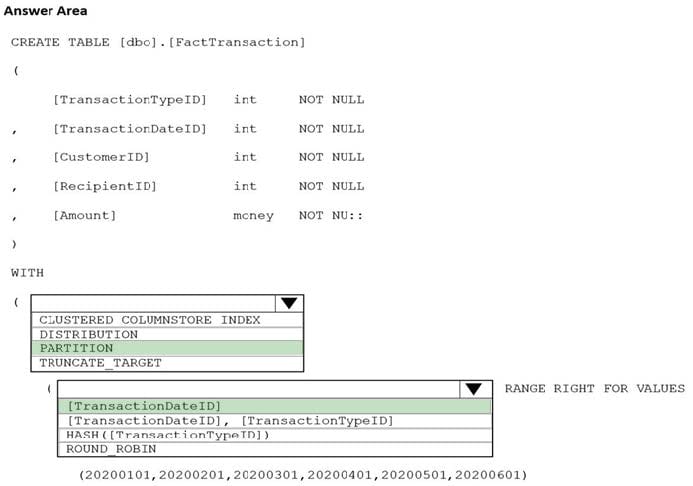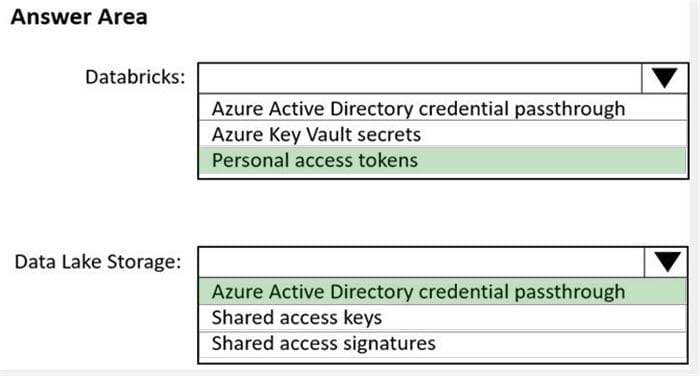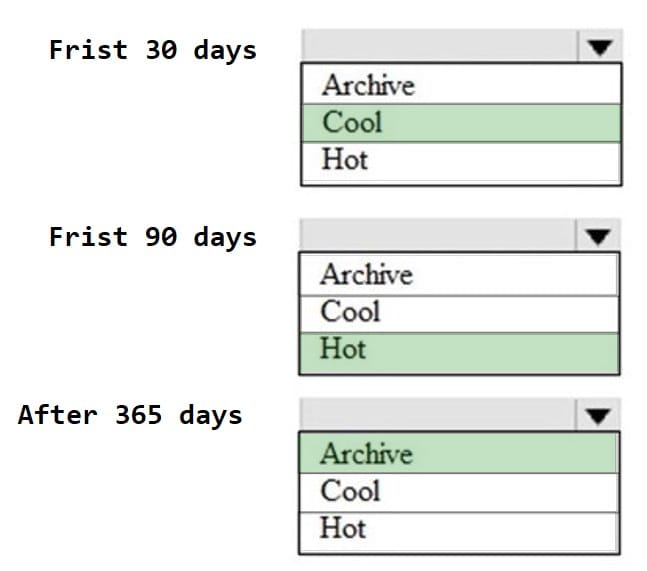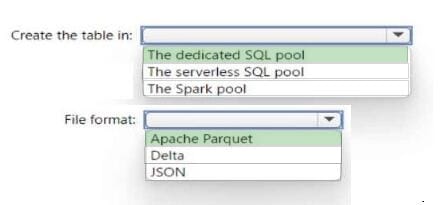DP-203 Online Practice Questions and Answers
DRAG DROP
You need to create a partitioned table in an Azure Synapse Analytics dedicated SQL pool.
How should you complete the Transact-SQL statement? To answer, drag the appropriate values to the correct targets. Each value may be used once, more than once, or not at all. You may need to drag the split bar between panes or scroll to
view content.
NOTE: Each correct selection is worth one point.
Select and Place:

HOTSPOT
You are designing an Azure Stream Analytics solution that receives instant messaging data from an Azure event hub.
You need to ensure that the output from the Stream Analytics job counts the number of messages per time zone every 15 seconds.
How should you complete the Stream Analytics query? To answer, select the appropriate options in the answer area.
NOTE: Each correct selection is worth one point.
Hot Area:
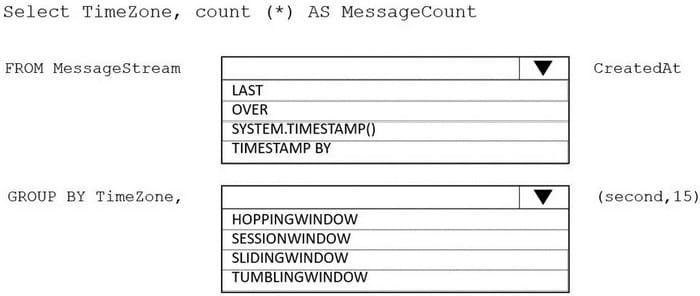
HOTSPOT
You are building an Azure Synapse Analytics dedicated SQL pool that will contain a fact table for transactions from the first half of the year 2020.
You need to ensure that the table meets the following requirements:
1.
Minimizes the processing time to delete data that is older than 10 years
2.
Minimizes the I/O for queries that use year-to-date values
How should you complete the Transact-SQL statement? To answer, select the appropriate options in the answer area.
NOTE: Each correct selection is worth one point.
Hot Area:
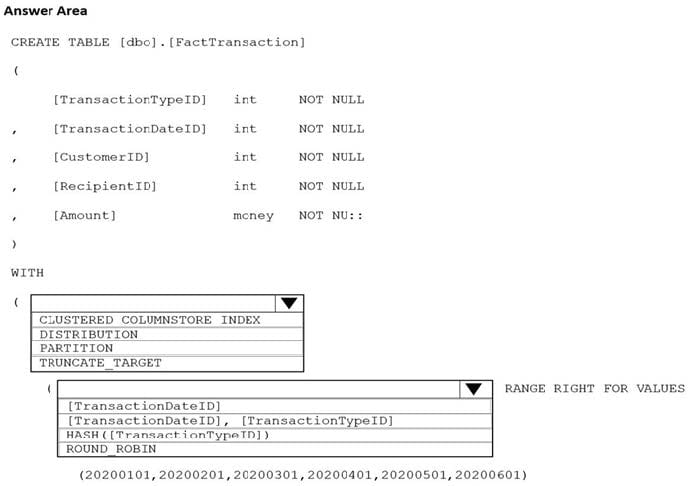
HOTSPOT
You use Azure Data Lake Storage Gen2 to store data that data scientists and data engineers will query by using Azure Databricks interactive notebooks. Users will have access only to the Data Lake Storage folders that relate to the projects
on which they work.
You need to recommend which authentication methods to use for Databricks and Data Lake Storage to provide the users with the appropriate access. The solution must minimize administrative effort and development effort.
Which authentication method should you recommend for each Azure service? To answer, select the appropriate options in the answer area.
NOTE: Each correct selection is worth one point.
Hot Area:
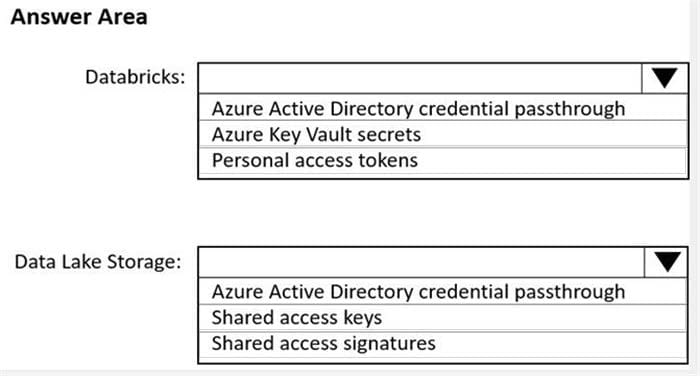
HOTSPOT
You are designing an application that will use an Azure Data Lake Storage Gen 2 account to store petabytes of license plate photos from toll booths. The account will use zone- redundant storage (ZRS).
You identify the following usage patterns:
1.
The data will be accessed several times a day during the first 30 days after the data is created.
2.
The data must meet an availability SU of 99.9%.
3.
After 90 days, the data will be accessed infrequently but must be available within 30 seconds.
4.
After 365 days, the data will be accessed infrequently but must be available within five minutes.
Hot Area:
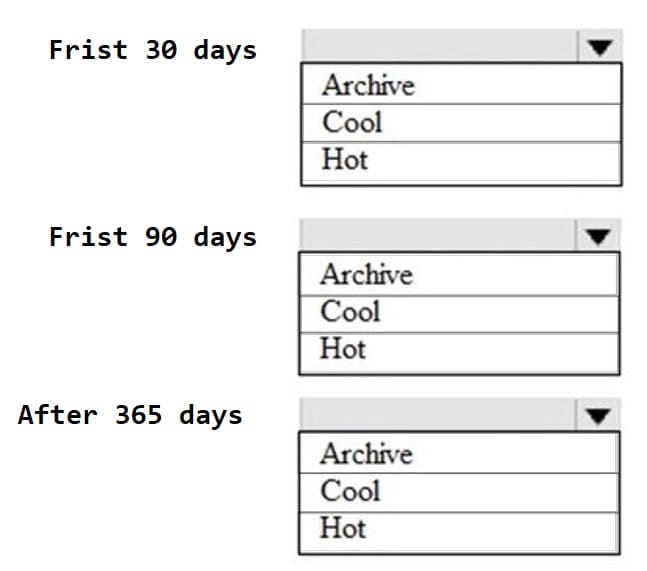
HOTSPOT
You have an Azure Synapse Analytics serverless SQL pool, an Azure Synapse Analytics dedicated SQL pool, an Apache Spark pool, and an Azure Data Lake Storage Gen2 account.
You need to create a table in a lake database. The table must be available to both the serverless SQL pool and the Spark pool.
Where should you create the table, and Which file format should you use for data in the table? To answer, select the appropriate options in the answer area.
NOTE: Each correct selection is worth one point.
Hot Area:
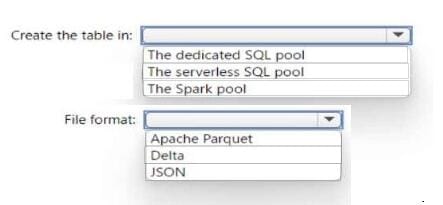
You have an Azure Synapse workspace named MyWorkspace that contains an Apache Spark database named mytestdb.
You run the following command in an Azure Synapse Analytics Spark pool in MyWorkspace.
CREATE TABLE mytestdb.myParquetTable(EmployeeID int,EmployeeName string,EmployeeStartDate date)
USING Parquet
You then use Spark to insert a row into mytestdb.myParquetTable. The row contains the following data.

One minute later, you execute the following query from a serverless SQL pool in MyWorkspace.
SELECT EmployeeIDFROM mytestdb.dbo.myParquetTableWHERE EmployeeName = 'Alice';
What will be returned by the query?
A. 24
B. an error
C. a null value
You need to design an Azure Synapse Analytics dedicated SQL pool that meets the following requirements:
1.
Can return an employee record from a given point in time.
2.
Maintains the latest employee information.
3.
Minimizes query complexity. How should you model the employee data?
A. as a temporal table
B. as a SQL graph table
C. as a degenerate dimension table
D. as a Type 2 slowly changing dimension (SCD) table
You have an enterprise-wide Azure Data Lake Storage Gen2 account. The data lake is accessible only through an Azure virtual network named VNET1.
You are building a SQL pool in Azure Synapse that will use data from the data lake.
Your company has a sales team. All the members of the sales team are in an Azure Active Directory group named Sales. POSIX controls are used to assign the Sales group access to the files in the data lake.
You plan to load data to the SQL pool every hour.
You need to ensure that the SQL pool can load the sales data from the data lake.
Which three actions should you perform? Each correct answer presents part of the solution.
NOTE: Each area selection is worth one point.
A. Add the managed identity to the Sales group.
B. Use the managed identity as the credentials for the data load process.
C. Create a shared access signature (SAS).
D. Add your Azure Active Directory (Azure AD) account to the Sales group.
E. Use the snared access signature (SAS) as the credentials for the data load process.
F. Create a managed identity.
You are designing an Azure Databricks table. The table will ingest an average of 20 million streaming events per day.
You need to persist the events in the table for use in incremental load pipeline jobs in Azure Databricks. The solution must minimize storage costs and incremental load times.
What should you include in the solution?
A. Partition by DateTime fields.
B. Sink to Azure Queue storage.
C. Include a watermark column.
D. Use a JSON format for physical data storage.
You are designing a dimension table for a data warehouse. The table will track the value of the dimension attributes over time and preserve the history of the data by adding new rows as the data changes. Which type of slowly changing dimension (SCD) should use?
A. Type 0
B. Type 1
C. Type 2
D. Type 3
You have an Azure Stream Analytics query. The query returns a result set that contains 10,000 distinct values for a column named clusterID.
You monitor the Stream Analytics job and discover high latency.
You need to reduce the latency.
Which two actions should you perform? Each correct answer presents a complete solution.
NOTE: Each correct selection is worth one point.
A. Add a pass-through query.
B. Add a temporal analytic function.
C. Scale out the query by using PARTITION BY.
D. Convert the query to a reference query.
E. Increase the number of streaming units.
After you answer a question in this section, you will NOT be able to return to it. As a result, these questions will not appear in the review screen.
You have an Azure Data Lake Storage account that contains a staging zone.
You need to design a daily process to ingest incremental data from the staging zone, transform the data by executing an R script, and then insert the transformed data into a data warehouse in Azure Synapse Analytics.
Solution: You use an Azure Data Factory schedule trigger to execute a pipeline that executes mapping data flow, and then inserts the data into the data warehouse.
Does this meet the goal?
A. Yes
B. No
You have an Azure subscription that contains a Microsoft Purview account named MP1, an Azure data factory named DF1, and a storage account named storage. MP1 is configured 10 scan storage1. DF1 is connected to MP1 and contains 3
dataset named DS1. DS1 references 2 file in storage.
In DF1, you plan to create a pipeline that will process data from DS1.
You need to review the schema and lineage information in MP1 for the data referenced by DS1.
Which two features can you use to locate the information? Each correct answer presents a complete solution.
NOTE: Each correct answer is worth one point.
A. the Storage browser of storage1 in the Azure portal
B. the search bar in the Azure portal
C. the search bar in Azure Data Factory Studio
D. the search bar in the Microsoft Purview governance portal
You need to implement the surrogate key for the retail store table. The solution must meet the sales transaction dataset requirements. What should you create?
A. a table that has an IDENTITY property
B. a system-versioned temporal table
C. a user-defined SEQUENCE object
D. a table that has a FOREIGN KEY constraint


